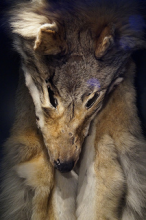Article
In some indigenous traditions, it is taboo to kill certain animals, such as bears, coyotes, wolves, and cougars, and their pelts are forbidden from being used. Therefore, for an individual to make use of or to wear a wolf skin can be considered a radical if not offensive practice.
In some versions of Navajo tradition, for example, skinwalkers are said to wear an animal skin in order to obtain the attributes, power, and nature of the animal from which the skin was taken. In other versions of this mythology, skinwalkers are described as mutated versions of the animal whose skin they're wearing.
Because of these beliefs, sometimes it is said that the Navajo call the wolf "mai-coh," meaning witch. Here, the suspicion toward wolves derives not from the nature of the wolf, but rather from human nature. Both the Navajo and the Hopi believed that human witches use or possibly abuse the wolf's powers to hurt other people. While Europeans warn of a wolf in sheep's clothing, some traditional indigenous beliefs caution against a human in wolf's clothing.
"Wolf Skin" by Silly Little Man is licensed under CC BY-SA.
Manuscripts
A01 The Blessing Way (01-07) p.13
A01 The Blessing Way (01-07) p. 22
A01 The Blessing Way (01-07) p. 64
A01 The Blessing Way (01-07) p. 108
A01 The Blessing Way (01-07) p. 111
A01 The Blessing Way (01-07) p. 118
A01 The Blessing Way (01-07) p. 131
A01 The Blessing Way (01-07) p. 132
A01 The Blessing Way (01-07) p. 136
A01 The Blessing Way (01-07) p. 139
A01 The Blessing Way (01-07) p. 226
A01 The Blessing Way (01-07) p. 227
References
Lynch, Patricia Ann
2004 Skinwalker. Native American Mythology, Mythology A to Z. Facts On File, Inc., New
York.
Lynch, Patricia Ann
2004 Witches in American Indian Mythology. Native American Mythology, Mythology A to
Z. Facts On File, Inc., New York.

